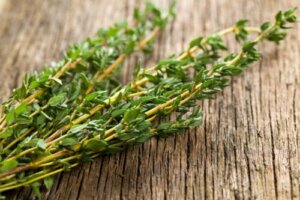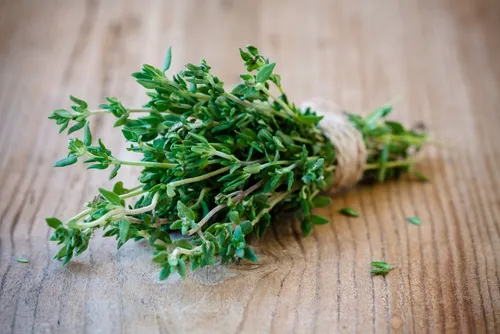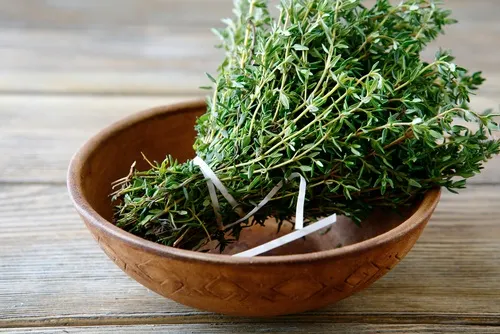The Antiparasitic Properties of Thyme

In this article, we’ll tell you about the antiparasitic properties of thyme and its beneficial effects on the organism. Among other positive consequences, it helps to eliminate lice, parasites, and fleas.
What to know about thyme
Thyme is an aromatic shrub that’s used to give flavor and aroma to food. However, it’s also a potent natural remedy.
Thyme has been used since ancient times – there are traces of its use in Roman times, for medicinal purposes, and also to perfume wines and cheeses. Nowadays, other properties are also recognized, such as aesthetic properties.
What is thyme used for?
The most frequent uses of thyme have to do with gastronomy. However, it also has benefits for the digestive and respiratory systems. This plant is used to:
- Reduce gas, due to its carminative properties.
- Relieve coughs and phlegm, due to its expectorant properties.
- Treat wounds, and even open wounds, for its antiseptic power.
- Balance the pH of the scalp and eliminate dandruff and dermatitis.
- Relieve oral problems such as gingivitis or canker sores.
- Treat Candida albicans infections or vaginitis.
- Reduce the pain caused by rheumatism or arthritis.
- Promote blood circulation.
- Prevent premature aging of cells, as it has antioxidant properties.
- To help women with painful or difficult menstrual periods, as it is an emmenagogue.
- Reduce the intensity of migraines and migraine headaches.
- Strengthen the immune system and prevent colds and flu.
- Combat all types of urinary system infections (urethritis, cystitis, prostatitis).
- Prevent bad breath.
- Keep teeth healthy.
- Treat diarrhea in children.
- Repel mosquitoes and other insects.
However, not all of these properties are backed up by science, but literature does show its antimicrobial properties.
It also states that combining thyme with pharmacological treatment improves the prognosis in cases of bronchitis, according to an article published in the journal “Arzneimittelforschung”.

Read also: The Benefits of Thyme: Discover Its Uses
The antiparasitic properties of thyme
Internal use
Since ancient times, thyme has been used to eliminate intestinal parasites. It’s also used to combat worms. However, this is a natural remedy whose effectiveness isn’t supported by the scientific community.
To take advantage of these properties, it’s necessary to drink a laxative herbal tea, which helps to expel pinworms, a very common parasite in children. We’ll tell you how to prepare this infusion:
Ingredients
- ½ liter of water
- 2 tablespoons of thyme
Preparation
- Boil the thyme for 10 minutes.
- After that time, turn off the heat and let it stand until lukewarm.
- Strain, and drink on an empty stomach.
- Don’t sweeten, dilute or mix with other beverages.
- Repeat the treatment for 1 week. During these 7 days, refined sugars and flours should be avoided.
Internal parasites
Adults who have internal parasites can carry out a treatment to combat them based on the antiparasitic properties of thyme. It should be noted that this natural remedy shouldn’t replace the pharmacological treatment.
These are the steps for its preparation:
Ingredients
- 1 handful of fresh thyme
- 1 liter of water
Preparation
- Put the thyme in a saucepan and boil.
- Leave for 15 minutes and remove from the heat.
- Cover for another 15 minutes.
- Filter and drink the whole liter of water throughout the day; the first drink should be on an empty stomach and the last one before going to sleep.
- Repeat the treatment for a week and carry out a detox diet, including vegetables, fruits, and whole grains. Everything that contains fiber to promote the elimination of worms and amoebas will be beneficial.
External use
Its antiparasitic action doesn’t only apply to intestinal worms, but also serves to eliminate fleas, lice, scabies and fungus on the nails or skin. Here’s how:
Ingredients
- 1 liter of water
- 120 grams (5 oz) of dried thyme flowers and leaves
Preparation
- Heat the water and add the flowers.
- Bring to a boil until the water is reduced by half.
- Remove from the heat, and let it stand and cool.
- Filter and soak a cotton ball in the liquid.
- Apply to the scalp, skin, or nails, as appropriate.
- In more advanced cases, you can wash or compress the affected area with a cloth.
- Either of the two treatments should be followed for eight days, then rest for two weeks and repeat so as not to suffer from regrowth.

Why is thyme so good for these conditions? Because it has a compound called thymol, which inhibits the growth of mites, ringworms and other parasites according to experts. For this reason, it fights bacteria, amoebas, fungi, etc.
In addition to the topical treatment that we detailed above, you can make a remedy that works for all these conditions and that you can store for several weeks. These are the instructions:
Ingredients
- Fresh or dried thyme
- Alcohol
Preparation
- In a jar, place 4 tablespoons of thyme and pour white alcohol up to the rim.
- Cover tightly and let it stand for 3 weeks in a dark, cool place.
- After that time, soak a cotton ball and rub the affected area, which can be the scalp, skin, or nails.
- Another option is to apply it as a poultice and leave for 15 minutes (for scabies, lice, or fungus).
You may be interested in: The Amazing Benefits of Thyme Tea
Gastronomic use
The last of the ways to take advantage of the benefits of thyme that we’ll mention here is in food. It can be used for:
- Fish
- Seafood
- Vegetables
- Chicken
- Vinegar
- Oils
- Sauces
- Marinades
- Dressings
Does thyme have any side effects?

Although it’s one of the least toxic plants that exist, excessive consumption can cause what’s called thyrotoxicosis, which consists of various clinical disorders due to increased levels of thyroxine.
Therefore, it’s necessary to comply with an internal treatment of no more than a week and let the body rest a fortnight before repeating. In the case of topical use, close attention should be paid to the reactions of the skin or nails to detect possible allergies. Medical consultation is highly recommended if symptoms persist or worsen.
In summary…
The antiparasitic uses of thyme can be very positive and can fight some infections thanks to its antimicrobial properties. In addition, it can improve the organoleptic quality of your dishes.
For this reason, we encourage you to try to use it more often, along with other spices.
All cited sources were thoroughly reviewed by our team to ensure their quality, reliability, currency, and validity. The bibliography of this article was considered reliable and of academic or scientific accuracy.
- Rosas, A., & López, A. (2011). Actividad Antimicrobiana de Aceite Esencial de Tomillo. Temas Selectos de Ingeniería de Alimentos. https://doi.org/10.1145/1978942.1978984
- Folcarà, S. C., & Vanaclocha, B. (2000). Usos terapéuticos del tomillo. Revista de Fitoterapia, 5–13.
- Sakkas H., Papadopoulou C., Antimicrobial activity of basil, oregano, and thyme essential oils. J Microbiol Biotechnol, 2017. 27 (3): 429-438.
- Kemmerich B., Eberhardt R., Stammer H., Efficacy and tolerability of a fluid extract combination of thyme herb and ivy leaves and matched placebo in adults suffering from acute bronchitis with productive cough. A prospective, double blind, placebo controlled clinical trial. Arzneimittelforschung, 2006. 56 (9): 652-60.
- Salehi B., Mishra AP., Shukla I., Sharifi Rad M., et al., Thymol, thyme and other plant sources: health and potential uses. Phytother Res, 2018. 32 (9): 1688-1706.
This text is provided for informational purposes only and does not replace consultation with a professional. If in doubt, consult your specialist.








